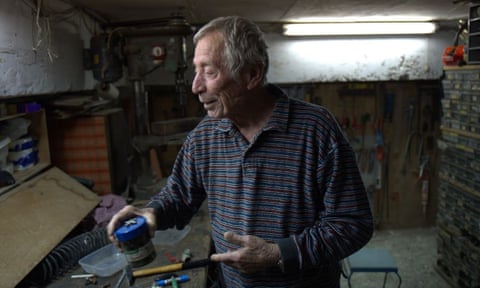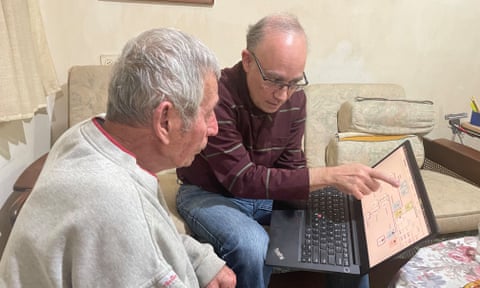Join Date: Feb 2011
Posts: 50,331
Thanks: 28,747
Thanked 14,428 Times in 10,234 Posts
|
 re: The Jewish Schindler: Woman Posed as Countess to Fool NAZIS & Save 10,000 Lives
re: The Jewish Schindler: Woman Posed as Countess to Fool NAZIS & Save 10,000 Lives
‘I Knew Nothing’: The Warsaw Ghetto Boy Who Found His Family at 83
A DNA test has helped Shalom Koray find relatives in the US after escaping the Holocaust in a rucksack at the age of two
The Guardian 27 JAN 2024
 In 1943, a two-year-old boy found wandering the streets of the Warsaw ghetto at the height of the Jewish uprising was smuggled out in a rucksack, probably by a police officer.
In 1943, a two-year-old boy found wandering the streets of the Warsaw ghetto at the height of the Jewish uprising was smuggled out in a rucksack, probably by a police officer.
The identity of the child could not be known. There was no one to attest even to a first name. His early life would be spent hidden away in orphanages, still not safe from antisemitic persecution, and without any real understanding of what it was to have a parent.
Five months ago, that same boy, now 83, discovered a family thanks to the desire of an American woman to trace her ancestry, the curiosity of a Polish academic about the plight of those orphaned by the Holocaust, and an advance in DNA technology that has made the dogged efforts of a researcher possible.
Shalom Koray, the name the boy was given at the age of eight on emigrating to Israel in 1949, will this summer meet for the first time a blood relative beyond that of his own three children and eight grandchildren: Ann Meddin Hellman, 77, a cousin from Charleston, South Carolina.
It might be said to represent a defeat, however small, for the hate that destroyed so many futures, the consequences of which are being marked on Saturday’s Holocaust Memorial Day – the 79th anniversary of the liberation of the Auschwitz-Birkenau death camp.
 Shalom Koray, who has worked on trucks for most of his life in Israel.
Shalom Koray, who has worked on trucks for most of his life in Israel.
“You can’t go looking for something if you don’t know what you want to find,” said Koray of the family he has found. “I didn’t know anything. If not for the DNA test, like, there is nothing.”
Koray had been left in the care of a Catholic institution named after Saint Andrew Bobol, in Zakopane, a town in southern Poland, after being smuggled out of the ghetto in 1943.
It was here that Lena Küchler-Silberman, a Polish Jew who had worked for the resistance under an alias, found him and other orphans, emaciated and wild, after the war.
She had been tasked by what she described as the Jewish committee to look after them with the intention of taking them to Palestine.
Koray remembers his heroine visiting. “We sat there, I don’t know what we were doing, loads of children inside a hall, without chairs, without anything,” he recalled. “In the middle a fireplace. She stood at the door and started throwing candies into the hall. I told myself: ‘If I leave the fireplace I will lose my spot next to it’. I gave up the candies. I stayed next to the fireplace.”

Lena Küchler-Silberman with Shalom Koray to her right and other children.
In an interview in 1946, Küchler-Silberman gave her own recollection. “When I appeared with the candy before the children, these children threw themselves at me with such violence, and screamed so frightfully,” she said. “One child trampled on the other, and one pushed away the other … These children pushed me completely against the wall, and the mother superior had to rescue me. And these were all children from two to five years old.”
She took five Jewish children, three boys and two girls, to join as many as 100 others. They travelled to Czechoslovakia, France and finally, in 1949, a smaller group emigrated with Küchler-Silberman to Israel. Koray, who had been given the name Piotr Korczak in Poland, was adopted and his name was changed. He lives in northern Israel today, and has worked on trucks for most of his life.
Koray’s history would have remained a mystery but for the work of Magdalena Smoczyńska, a professor emeritus at the Jagiellonian University.
For five years, Smoczyńska has been researching the fate of approximately 100 children who survived the Holocaust and ended up in orphanages at the end of the war, including the one in Zakopane.
Last summer, she approached Koray and asked him for a cheek swab to put through a MyHeritage DNA test, which could be used to potentially find a match with others.
In September, on the other side of the world, Ann Meddin Hellman, whose interest in Jewish ancestry saw her honoured in South Carolina with the Order of the Jewish Palmetto in 2015, received notification of such a match.
“His name meant nothing to me,” she admitted, but thanks to the work of a genealogy expert at MyHeritage, Daniel Horowitz, a family tree was slowly built up.

Shalom Koray with Daniel Horowitz, showing him something on a laptop
It emerged that Meddin Hellman’s grandfather, Abrahm Louis Mednitzky Meddin, had emigrated to the US in 1893, unknowingly saving his side of the family from the horrors of the coming genocide in Europe.
He had had a brother, Yadidia Mednitsky, who fatefully stayed behind. The DNA test proved that Koray was in all likelihood Mednitsky’s grandson.
Familial similarities only added to the shock. Meddin Hellman said:
“When the picture came through, my husband and I said, ‘That’s my brother’. We have all thought that this branch of the family was wiped out. Finding Shalom is a miracle.”
|